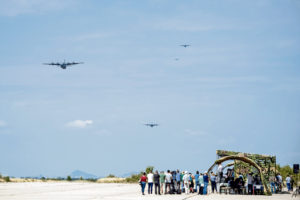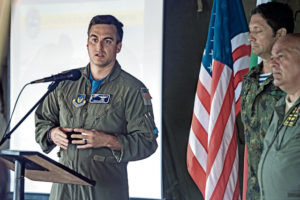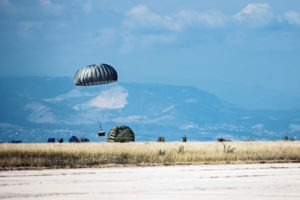
PLOVDIV, Bulgaria — Members from the Bulgarian government met at the Cheshnegirovo landing zone to watch tactical airlift sorties flown during Thracian Summer 2020 in Plovdiv, Bulgaria, Aug. 19.
Thracian Summer 2020 is a bilateral flying deployment allowing both the U.S. Air Force and Bulgarian military forces to extend joint warfighting capabilities through operational and tactical training.
“Every day we perform interfly formations with the Bulgarian C-27J Spartan,” said U.S. Air Force Capt. Claude Van Hook, 37th Airlift Squadron C-130J Super Hercules aircraft instructor pilot. “We have conducted mountainous visual low-levels, assault landings and take-offs and static-line personnel drops.”
The 37th AS, stationed at Ramstein Air Base, conducted airlift operations alongside the Bulgarian air force for the distinguished visitors. Three C-130J Super Hercules aircraft flew an interfly formation with a Bulgarian C-27J Spartan, air-dropped container delivery systems and Bulgarian parajumpers, and conducted an assault take-off at Cheshnegirovo for all to see.
“When we work with people who have experience operating in a coalition environment, deploying troops abroad and understanding the logistical support needed to execute the missions, it’s better to learn from them than have to start from scratch,” said Bulgarian Col. Yuri Lukanov, Bulgarian exercise director. “That’s why I love working with the U.S.”

Forward locations, like Plovdiv Airport and Cheshnegirovo, enable a collective defense capability and provide the U.S. and NATO the strategic and operational breadth needed to deter adversaries and assure partner nations.
“Operating from Plovdiv Airport is not going to be the same as operating out of Ramstein Air Base,” Van Hook said. “However, proximity to where we want to operate is a key advantage which helps our efficiency when identifying changes in infrastructure, improving our flexibility to meet mission requirements in the future.”
The 435th Contingency Response Group surveyed and secured the terrain at Cheshnegirovo. In addition, they controlled the LZ and drop zone to uphold safety during the demonstration of the unique capabilities the two countries have been training during Thracian Summer 2020.
“All of the flying and training that we’ve done has increased our readiness, enhanced our interoperability with the Bulgarian air force and heightened our ability to support each other; ultimately, persistently supporting NATO allies and partners,” said U.S. Air Force Maj. Derek Andeweg, 37th Airlift Squadron C-130J Super Hercules aircraft pilot.
Continual exercises and interactions between allied and partner forces allow the U.S. and NATO to work together as a team to enable all participants toward an international coalition.
“One of my favorite characteristics of the U.S. military members is their willingness to meet new people, learn new cultures and create friendships,” Lukanov said. “That’s why it’s not only easy, but also enjoyable to work with the United States.”

U.S. forces throughout the region bring unique and appropriate capabilities to complement Bulgaria’s military forces and remain a symbol of American commitment to Bulgaria’s continued peace and prosperity.
“We will fly with the Bulgarian air force any day of the week,” Andeweg said.


